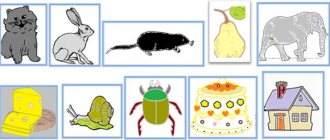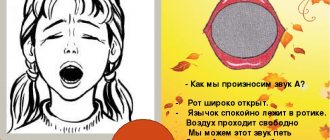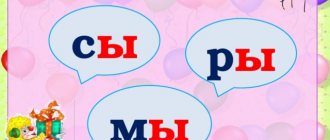Benefits of classes:
- These classes will enable the child to better acquire knowledge about the variety of sounds and letters;
- will form ideas about words and that words consist of sounds;
- will be a good assistant in the formation of phonemic hearing (the ability to hear and distinguish sounds in speech);
- With the help of adults, children will learn to distinguish sounds in speech, and therefore pronounce them correctly.
- Completing these tasks will help prepare children for learning to read and write in the senior group of kindergarten and in preparation for school.
Each lesson is located on 2 sheets of A4 format. You can print on two sheets, or on one - a page on each side. Total, 50 sheets - 50 full-fledged lessons on developing the pronunciation side of speech and teaching literacy.
The classes are developed based on our website. On the site you will find colorful illustrations, games and exercises to help with the printouts.
Instructions included.
Each lesson contains detailed instructions on how to complete the tasks. Tasks include: a description of the sound being studied, a graphic representation of a letter, a copy of letters, many illustrations of sounds and other interesting material.
In order for the child to find it both interesting and useful at the same time, the classes are supplemented with numerous coloring books . This is both visibility for the child and the development of fine motor skills of the fingers . Let us remind you that it is better to color with triangular pencils: they fit better in the child’s fingers.
MAGAZINE Preschooler.RF
Author: Mozgova Lyudmila Gennadievna Teacher-speech therapist, GBDOU kindergarten No. 26, Krasnoselsky district of St. Petersburg Games and play exercises for teaching literacy. Working as a speech therapist in a speech group with children diagnosed with “General speech underdevelopment,” I was faced with the problem that my children had a hard time mastering the material in literacy classes, they experienced significant difficulties in the process of mastering the skill of reading, and did not always understand the meaning of what they read. , while reading they make a significant number of different errors.Mastering literacy is a complex activity that requires a certain degree of maturity of many mental functions of the child and a fairly high level of development of oral speech. If children with normal speech throughout preschool age acquire vocabulary, master grammatical forms, and become ready to master the sound and morphological analysis of words, then in children with various forms of speech pathology there is a lag in the development of these processes. Children do not sufficiently distinguish by ear phonemes that are similar in articulatory or acoustic characteristics. Children diagnosed with “General speech underdevelopment” are at risk for dyslexia. Dyslexia manifests itself in numerous errors when reading; errors persist for a long time and are persistent, specific, repetitive, and typical. Since remedial teaching of the beginnings of literacy has the following goals: to form in children the necessary readiness for learning to read and write and to teach children to read and write, a system of special exercises was identified aimed at preparing children for learning to read and write and mastering its elements. I conduct all exercises in a playful, entertaining form, since play is the main activity of preschool children. Practical experience shows that learning in a game is much faster and stronger than when using only didactic techniques. Using games in literacy classes helps me relieve tension in children, study and consolidate difficult (theoretical) material at the level of emotional awareness. I also use play methods due to the fact that children with general speech underdevelopment develop educational and cognitive interests late and retain play motivation for a long time. Literacy classes are aimed at developing conceptual theoretical thinking and it is impossible to do without games that serve the central and most difficult stage of learning: the stage of introducing theoretical concepts. The game introduces into these concepts that figurative, sensual content that the verbal definitions of new abstract knowledge, and even its visual diagrams and models, lack. A game, as a result of which children form concepts of a new type and rebuild their idea of a word, can be called educational in the strict sense of the word. How is an educational game constructed? A sample of a new educational action (isolating sounds in a word, distinguishing between vowels and consonants, etc.) is initially given to children in an imaginary play situation; we are sent to a fairy tale. From the very first literacy lesson, I begin to tell the children a fairy tale (its conventional name is “Masha’s Journey through the Land of the Russian Language”) and in subsequent classes I constantly return to the heroes of this fairy tale. As necessary, new conditional characters are introduced that personify the introduced concepts. Dunno, Pinocchio, Carlson cannot personify the content of linguistic concepts. But the fairy phonetics helps us learn more about sounds, introduces us to Tim and Tom, who perfectly embody the distinction between hard and soft consonants. Fairy Graphics is responsible for letters, for correct reading. A percussion master will help you find a stressed syllable. Korney Korneich will talk about words with the same root - relatives. Actions with words or their sound patterns are performed by children on behalf of these linguistic characters.
Basic requirements for games used in literacy classes. 1. When choosing the rules of the game, the characteristics of children of this group (subgroup) are taken into account. 2. The game must correspond to the goals of the lesson and contribute to their implementation (the educational goal of the lesson). 3. The game, in addition to educational ones, must have gaming tasks. 4. At the end of the game, the results are summed up and the winners are identified in the person of one child or group. Games were developed with these requirements in mind. And it was noticed that the most effective games are those that include actions necessary for the development of reading skills, when reading becomes not an end in itself, but a means of achieving a game goal. Based on the fact that the leading symptoms of dyslexia at the initial stage of mastering reading are the weakness of the formation of sound-letter connections (this appears in the inability to master sound-letter symbols in due time) and the inability to develop syllable fusion skills, much attention is paid to working on sounds, letters and syllables .
Plan for working on sounds and letters 1. Isolating sounds from a yard of syllables and words. 2. Determining the place of sound in a word. 3. Coming up with words for a given sound. 4. Clarification of articulation and sound characteristics. 5. Introducing the letter. 6. What elements does a letter consist of? 7. What does the letter look like? 8. Recognition of a given letter among other letters. 9. Determining the spatial relationships of the elements of letters, the location of the letter on a sheet of paper. 10. Work with letter tables on the distribution of attention. I will dwell only on those types of games and gaming exercises that I most often use in my classes and which, in my opinion, are the most effective. Games at the sound and letter level. Isolating sounds from words.
Game control “Postcards” The speech therapist shows the children a postcard and names a word, 10-15 postcards are presented - words. It is necessary to remember the words and name them in the order in which they were named. For better memorization, words are linked together into a story or fable. Girlfriends - park - princess - poodle - bird - palm tree - postman - parcel - gift - Pavlik - briefcase - gingerbread - palm tree. Children remember and name words, determine which sound is found in all these words, and give it a characteristic. The “Writing” exercise is carried out in a similar way, but the children are presented not with postcards, but with a string of words. Olya - autumn - vacation - island - sheep - vegetables - donkey - shoes - wasps - cloud - windows - hoop - perch - lake.
Game exercise “Light a flashlight.” Instructions: light a flashlight if there is a sound in a word..... The speech therapist slowly pronounces the words, children raise signals when they hear the sound.
Game "Unusual Flowers". Goal: Find a given sound in a word. From a series of pictures - petals, children choose only those whose names contain a given sound and form a flower.
Game “Fisherman” Purpose: Determining the place of a sound in a word. Children use a fishing rod to catch cards with pictures and name the words, clearly pronouncing all the sounds. At the end of the game, the children are asked to name all the words again and determine what sound came to visit us today.
Game "Snail - traffic light". This board and printable game is designed for all sounds. Let's take, for example, a field with the sound A. Purpose: to train children in finding the place of the sound A in a word. Equipment: playing field with subject pictures, red, yellow, green chips (traffic light colors) symbolize the beginning, middle, end of the word. Progress of the game. Children are divided into teams and take turns naming words, determining the place of the sound A in the word. If the sound is at the beginning of the word, a red chip is given, in the middle - yellow, at the end - green. When all the words and pictures are named, the result is summed up. The team that made the most traffic lights from the collected chips won.
Game exercise “Traffic light”. The speech therapist calls the word, the children determine the location of the given sound in this word and raise the signal (red, yellow or green).
Game exercise “Houses”. On the children's tables there are houses with three windows (diagram: beginning, middle, end of the word) and object pictures. It is necessary to determine the place of a given sound in a word and insert a picture into the desired window. Introducing the letter. A stable graphic image of a letter must be formed on a polyanalyzer basis. To do this, I use such game exercises as tracing the outline of convex relief letters with a finger, tactile identification of “emery” letters - “Reading Fingers”, the game “Wonderful Bag” with letters, labyrinths - “What letters were written by Masha and Misha with skates on ice”, noisy pictures - “The letters have scattered” (for example, find the letter A and outline it with a felt-tip pen). Grouping of letters. Children are asked to find all the letters on the letter table, for example, A, and cover them with chips or fingers. A more complex option is when children look for 2 letters (for example, A, U) and cover them with chips of different colors or with the fingers of their right and left hands. Working with letter tables on the distribution of attention. Game exercise “Twins”. For example, a table is given, on it are the letters A of different fonts, each letter in duplicate - “twins”. Task: find two identical letters and cover them with the fingers of your left and right hands. Work starts from the top row and proceeds line by line from left to right.
Game exercise “Smart felt-tip pens” or “Obedient felt-tip pen”. I took the “Electronic Fly” as a basis, but in this exercise there is no support on the cage; the children do the work on a blank sheet of paper. The instruction is given: “The felt-tip pen will carry out all my commands and let’s see what it writes to us.” First, I explain to the children that the felt-tip pen takes “steps” and steps only in the direction I name (up, right, down, left). Children must follow the instructions exactly and compare their letter with the model. The one whose letter matches the pattern wins. For example, up, up, right, down, down P right, down, left, up, up, right B Game exercise “Magic Square” - finding letters in geometric shapes. , U, X, M, P U, Sh, , E, S
Exercises on designing and reconstructing letters. Making letters from matches, strings, from a “letter constructor” (arc - semicircle, short and long stripes).
Game exercise “Transforming letters”. Equipment: “letter constructor” for each child. For example, make the letter “O” - O, turn the letter “O” into “E” - E, “I” - I, into “P” - P
Game exercise “Logical chains”. H l N ? P ; JK F? R
Children really like the game “Living Letters”. “The sea worries once, the sea worries twice, the sea worries three – your favorite letter, freeze in place!” Children depict letters, and the teacher or child leader “reads.” Working with printed texts using proofreading type. Work at the syllable level. In the correction of dyslexia, the development of syllable fusion skills is of paramount importance. Reading syllables with already learned letters allows you to automate the reading of syllables and organize sound-letter connections. The completed letter is immediately introduced into the syllables. Direct and reverse syllables are composed. When reading syllables, the left hand rests on the table and it is necessary to constantly focus on what we are reading from left to right. At the initial stage, I use the game exercises “Chamomile” and “Butterflies” to compose syllables. Children like the “Butterflies” exercise more because they themselves can manipulate pictures - letters, form syllables and read. After 10-12 yuukv have been completed, an exercise such as reading syllabic tables is introduced. Work with tables is carried out in the form of the game “Loto” and is called “Close the Window”. The speech therapist names the syllable, the children find this syllable on their tables and close it (“window”) with a chip. The work begins with the tables SG-GS; they contain forward and backward syllables of the same letter composition (TO - OT, MA - AM). Such exercises give a good effect with regular use, complication (SGS, SSGS, SGSS) and frequent changes of tables. With the tables, you can conduct the “Bird Market” exercise by asking the children to read their card in a low voice. When reading syllables, guessing is impossible; when completing the task, the child is forced to rely only on syllable merging skills. Coming up with words for a given syllable. Game exercise “Wonderful bag”. The child is asked to take out a syllable, read it and come up with a word that begins with this syllable.
Game exercise “Crow’s tongue”, “Mouse’s words”. In the country of the Russian language, even mice can talk, but they can only say those words that can be “squeaked” - PI (those words that begin with the syllable PI-), the syllable is displayed on the board. What words are these? Piano, pajamas, pie, letter, etc. What words can a crow say? Potato, pocket, map, etc. The syllables MU, GA, KO, KVA are played out similarly.
Game exercise “Miracle - tree” or “tree and leaves”. Syllables are written on the branches. Children come up with words and attach the leaves to the corresponding branches. Using syllable cards we work on synthesis - we construct words. To compose words from given syllables, Voskobovich’s games “Reader” and “Nahlobushki” are actively used in classes; game "In a circle".
Game exercise “The word has crumbled.” It is carried out according to the principle of a cut picture, on one side of the card there are syllables, on the other - parts of the object. If the word is formed correctly, the cards with syllables are turned over and on the reverse side you get an object corresponding to the word read. Game exercise “Fisherman”. Children catch syllables on a fishing rod and read them. When the “aquarium” is empty, children are asked to make words from their syllables and explain their meaning.
Chain of words Purpose: to train children in identifying the first and last sounds in words. Equipment: cards with subject pictures. Progress of the game: 4-6 children play. Each child has 6 cards. The speech therapist begins to lay out the chain. The next picture is placed by a child whose name of the depicted object begins with the sound that ends with the word - the name of the first object. The winner is the one who lays out all his cards first.
Find the place of sound in a word Purpose: To train children in finding the place of sound in a word. Equipment: cards with diagrams of the location of sounds in words. Progress of the game: each child receives a card. The speech therapist shows pictures and names words. If a given sound is heard at the beginning of a word, you need to place a chip in the first cell. If a sound is heard in the middle of a word, the chip must be placed in the second cell. If the sound is at the end of the word, the chip is placed in the third cell. The winner is the one who made no mistakes.
Match the word to the diagram. Purpose: Same. Equipment: cards with diagrams of the location of sounds in words. Progress of the game: having received a card, the child selects 3 pictures/words with a given sound, focusing on the shaded square.
Find a pair Purpose: to train children in selecting words that differ from each other by one sound. Develop phonemic awareness. Equipment: sound clock, a set of subject pictures, words - paronyms. Progress of the game: the speech therapist places 6 pictures on the clock. For example: braid - braid, com - house, poppy - cancer. Children are asked to find pictures with objects whose names sound similar and differ only in one sound. Which one? The child who found these words first moves the arrows to the pictures. Children find all three pairs of words. The game can be repeated by replacing the pictures with new pairs/ barrel - kidney, wheelbarrow - dacha, T-shirt - seagull..../ Turn on the TV Purpose: to train children in identifying the first or last sound in words, in composing words from highlighted sounds, to practice reading words ( as a more complicated option). Equipment: “TV” manual, object pictures and cards with letters, pictures for the TV screen. Progress of the game: the speech therapist explains to the children: “To turn on our TV and see the image on its screen, you need to identify the first sound in the words - the names of objects placed in the top pocket. Using these sounds you will create a new word. If the word is spelled correctly, the corresponding item will appear on the screen. For example: matryoshka, stork, cat - MAC. The “poppy” picture appears on the screen. The highlighted sound can be designated by the corresponding letter and read. Light up the traffic light Goal: developing the ability to establish the place of sound in a word. Equipment: subject pictures, traffic lights for each child or red, yellow, green circles. Progress of the game: the speech therapist shows a picture, one child names the object depicted on it. Children repeat the word, find the place of the sound being studied in the word and raise the corresponding signal - light the traffic light - red circle - the beginning of the word, yellow - the sound in the middle of the word, green - the sound at the end of the word.
Houses Goal: developing the ability to differentiate similar sounds, find the place of a sound in a word. Equipment: a set of subject pictures, the names of which begin with oppositional sounds, 2 houses, each house has 3 pockets (beginning, middle, end of the word). Progress of the game: the child takes a picture, names it, determines the presence of a sound (for example: Ш or Ш), its place in the word, inserts the picture into the corresponding pocket. Points are awarded for correctly completed tasks. Fisherman Goal: developing the ability to establish the place of sound in a word. Equipment: small object pictures with a metal clip, a fishing rod, cards - diagrams “beginning, middle, end of the word” for each child. Progress of the game: “Catch” the word, determine the place of the sound in the word and place the picture in the appropriate box. Children take turns performing actions.
Mooring on a boat Purpose: to practice reading syllables. Equipment: a panel depicting piers with vowels, a boat (drawing) with a captain and a consonant. Progress of the game: today we will moor the boat to different piers. For example: on boat “L” to pier “A” the captain gives a signal: sound the horn LLLAAA! Then the pier will know that boat “L” is approaching pier “A” and will prepare for the meeting. What will we load at this pier? LAMP (you can immediately draw it or post a picture). But we still need a CHANDELIER and a LADDER to hang the chandelier. Which piers should you go to to get these things?
Flowers and butterflies Purpose: to practice reading syllables. Equipment: a panel depicting 10 flowers, each flower has a vowel letter. Butterflies, each with a consonant letter on its wing. Progress of the game: butterfly “M” flew over the flowers and landed on flower “U”. The speech therapist places a butterfly to the right of the letter. What song did you make? MU. And now the butterfly has crossed to the other side of the flower, what happened? MIND. Next, the children independently
| Next > |







